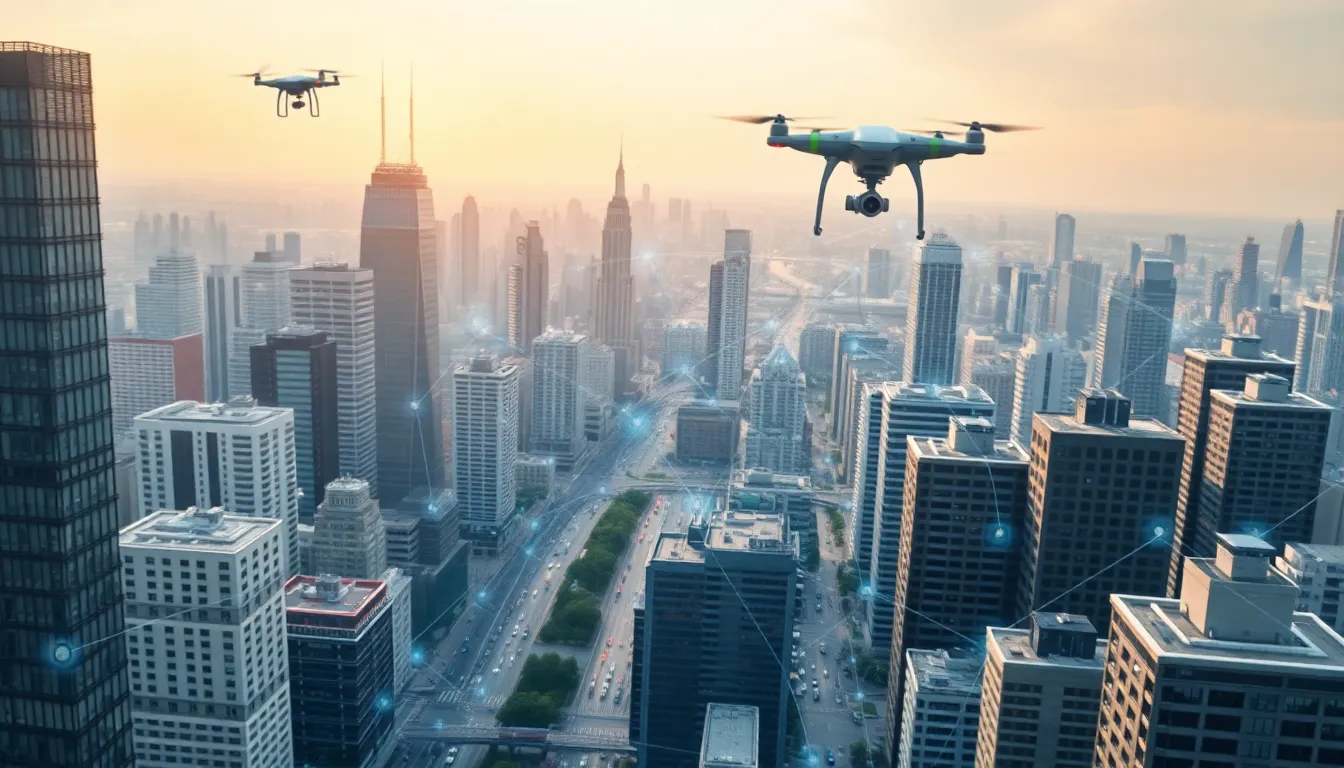Imagine a world where your fridge orders groceries while your car finds the quickest route to the nearest coffee shop—all without you lifting a finger. Welcome to the dazzling realm of 5G and the Internet of Things (IoT). This dynamic duo is set to revolutionize how we interact with technology, making our lives more convenient and, let’s face it, a bit more fun.
Table of Contents
ToggleOverview of 5G and IoT
5G technology significantly enhances Internet of Things (IoT) capabilities. This next-generation network offers increased speed, lower latency, and greater capacity compared to previous generations. Users experience seamless connectivity as billions of devices communicate in real time.
IoT encompasses various devices, including smart appliances, wearable technology, and connected vehicles. These devices collect and exchange data, enabling smarter decision-making. With 5G, IoT applications can access vast amounts of information quickly and efficiently.
Smart cities exemplify the integration of 5G and IoT. Technologies like connected traffic lights and smart waste management systems optimize urban living. Real-time data sharing improves efficiency in transportation, energy management, and public safety.
Healthcare also benefits from 5G and IoT. Remote monitoring devices enable doctors to track patient health data continuously. Immediate access to this data enhances patient outcomes and streamlines medical processes.
Manufacturing sees advancements through 5G and IoT integration. Smart factories utilize connected machinery to enhance production efficiency and minimize downtime. These technologies facilitate predictive maintenance, reducing unexpected equipment failures.
Overall, the fusion of 5G and IoT presents myriad opportunities across various sectors. Businesses and individuals alike can harness these innovations to create more efficient, responsive environments. Such advancements signal a shift towards an increasingly interconnected world.
Benefits of 5G for IoT
5G technology significantly enhances the Internet of Things, offering numerous advantages that improve device connectivity and overall functionality.
Increased Speed and Capacity
Increased speed plays a crucial role in the effectiveness of IoT applications. 5G networks provide download speeds up to 10 Gbps, enabling data-intensive applications to function seamlessly. More devices can connect simultaneously without compromising performance on 5G networks. A typical 5G network supports one million devices per square kilometer, allowing cities to integrate countless IoT solutions, such as smart traffic systems. Enhanced capacity also reduces network congestion, making data transmission efficient and reliable. As a result, industries can implement real-time monitoring that facilitates better decision-making.
Low Latency Connections
Low latency connections transform the responsiveness of IoT devices. With a latency of just 1 millisecond, 5G networks ensure that devices communicate almost instantaneously. This quick response time is especially vital for applications requiring immediate action, such as autonomous vehicles and real-time health monitoring systems. Improved latency promotes effective coordination among devices, enabling smoother interactions that enhance user experience. Furthermore, low latency supports applications across various sectors, from smart agriculture to logistics, ensuring better outcomes and operational efficiency.
Applications of 5G and IoT
5G technology and the Internet of Things create a plethora of applications across various sectors. These advancements redefine how individuals and organizations interact with their environments.
Smart Cities
Smart cities leverage 5G and IoT to enhance urban living. Connected traffic lights optimize vehicle flow, reducing congestion. Sensors in waste management systems monitor bin levels, leading to more efficient collections. Public safety improves with real-time surveillance cameras relaying information to law enforcement. The integration enables energy-efficient building management systems. These systems adjust heating and cooling based on occupancy data, which decreases utility costs. Smart city applications offer sustainable solutions through effective resource management.
Industrial Automation
Industrial automation relies heavily on 5G and IoT for increased efficiency. Factories implement connected machinery for real-time monitoring, which reduces equipment downtime. Predictive maintenance algorithms analyze data from machines, identifying issues before they disrupt production. Enhanced communication between machines streamlines supply chain operations. Employees benefit from augmented reality devices that provide training and guidance, innovating workforce development. Data-driven decisions derived from IoT insights lead to higher productivity levels. Overall, industrial automation capitalizes on these technologies to drive growth and efficiency.
Health Care Innovations
Health care innovations significantly benefit from 5G and IoT integration. Remote monitoring devices allow healthcare providers to track patient vitals in real time, enabling timely interventions. Wearable technology collects data about physical activity and health metrics, which supports personalized care plans. Telemedicine services expand access to specialists, reducing the need for in-person visits. Enhanced connectivity ensures that medical devices communicate seamlessly, improving treatment accuracy. Additionally, smart hospitals utilize IoT for asset management, optimizing the use of medical equipment. The result is a more responsive and efficient health care system.
Challenges in Implementing 5G and IoT
Implementing 5G and IoT presents several challenges that need to be addressed for optimal function and deployment across various sectors.
Infrastructure Requirements
Infrastructure for 5G and IoT demands significant investment and development. Network operators require extensive upgrades to existing cellular towers and base stations to support higher frequencies. Dense deployment of small cells, often needed for urban areas, addresses the need for improved coverage and capacity. Fiber optic connections play a critical role, providing the necessary backbone to handle increased data traffic. Additionally, cities need to invest in smart infrastructure and integrate it with existing systems to leverage the benefits of 5G and IoT fully.
Security Concerns
Security remains a paramount concern with the expansion of 5G and IoT. Increased connectivity opens doors for cyberattacks, making networks more vulnerable. Many devices within the IoT ecosystem may have inadequate security measures, exposing sensitive data to unauthorized access. Network breaches can lead to severe consequences, such as data theft and disruption of services. Addressing these vulnerabilities requires continuous monitoring, regular software updates, and comprehensive security protocols to safeguard the integrity of connected systems.
Future Outlook of 5G and IoT
Anticipating the future of 5G and IoT reveals vast possibilities for enhanced connectivity and automation across multiple sectors. Smart home technologies are expected to become increasingly sophisticated, allowing for seamless interactions between devices. As consumer adoption rises, appliances will gain more advanced functionalities like automated inventory management and energy optimization.
Organizations are also investing in smart cities that leverage real-time data to improve urban life. Traffic light systems could adapt dynamically based on traffic flow, leading to reduced congestion and enhanced safety. Smart waste management systems will utilize sensors to optimize collection routes, thereby minimizing operational costs.
Healthcare stands on the brink of transformation through remote devices that provide continuous monitoring. Patients can expect improved outcomes thanks to devices transmitting real-time health data to healthcare providers. The integration of 5G with IoT in this field offers rapid response capabilities that can be life-saving.
Manufacturers are gearing up for smart factories that will maximize efficiency through connected machinery. Expect predictive maintenance to become standard, reducing downtime and operational costs. Increased automation will enable higher productivity levels and better resource management.
Despite these advancements, challenges remain in the widespread deployment of 5G infrastructure. Significant investment in small cell networks and fiber optics is critical to achieving the desired connectivity levels. Addressing security concerns is equally important, as the rise in connected devices elevates exposure to cyber threats. Comprehensive security protocols and continuous monitoring will be paramount in safeguarding these systems.
Embracing the integration of 5G and IoT opens up incredible opportunities while requiring strategic planning to mitigate challenges associated with their implementation.
Conclusion
The integration of 5G and IoT is set to revolutionize everyday life by enhancing connectivity and automation. With its unmatched speed and low latency, 5G enables a seamless experience for countless IoT devices, transforming how people interact with technology.
As smart cities evolve and industries adopt advanced IoT solutions, the benefits of this synergy will become increasingly apparent. However, the challenges of infrastructure development and security cannot be overlooked.
Strategic planning and investment will be crucial in harnessing the full potential of these technologies. Embracing 5G and IoT will undoubtedly lead to a smarter and more efficient future, paving the way for innovations that enhance convenience, safety, and overall quality of life.





